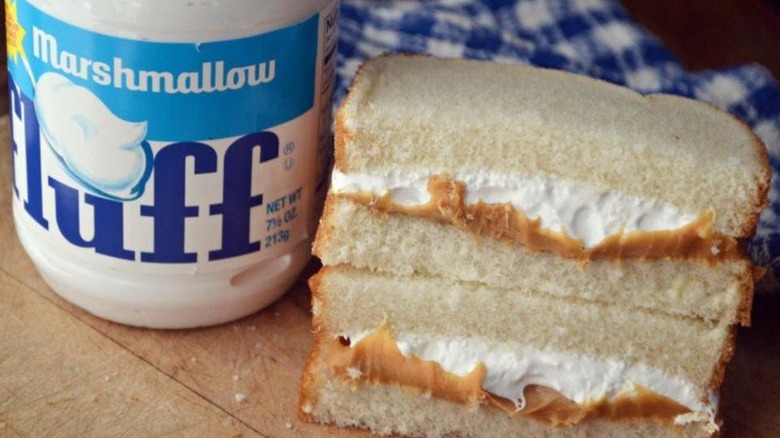The Pre-WWI Origins Of Marshmallow Fluff
Marshmallow Fluff is the ultimate New England comfort food. Ooey, gooey, and oh-so sugary-sweet, this sticky spread is the stuff of dreams. Today, it's perhaps best known for being the signature ingredient in the fluffernutter sandwich, a creamy and delicious partnership with peanut butter. However, there's no shortage of creative ways to use Marshmallow Fluff in your everyday cooking. Fluff is more than just a sweet treat; it's a nostalgic staple of any New England childhood. That's because this confectionery delicacy has deep roots in the Bay State, tracing its origins back over a century.
In the early 1910s, siblings Emma and Amory Curtis, direct descendants of American revolutionary Paul Revere, founded the Curtis Marshmallow Company in Melrose, Massachusetts. The company's flagship offering was Snowflake Marshmallow Crème, the first marshmallow spread available for purchase in stores. Using her own creation as a base, Emma Curtis would later go on to invent the fluffernutter. Despite the siblings' significant contributions to Massachusetts culture, it wasn't the Curtis Marshmallow Company that made the fluffy stuff a household name.
That distinction goes to Archibald Query, from Somerville, Massachusetts. In 1917, Query created his own marshmallow crème in his kitchen, which he called Marshmallow Fluff. Query went door-to-door selling the spread locally, but after WWI prompted sugar rations in the United States, he was forced to stop manufacturing his product. Enter H. Allen Durkee and Fred L. Mower, who quickly swept in, purchasing Query's recipe for just $500, equivalent to around $13,600, at the time of this publication.
Durkee and Mower made Marshmallow Fluff what it is today
After 12 years of small-scale sales, Durkee and Mower opened their own factory in 1929, a 10,000-square-foot facility in East Lynn, Massachusetts. The expanding company, fittingly named Durkee-Mower, hired only 10 employees, but its regional influence was increasing exponentially. For over a decade, beginning in 1930, Durkee-Mower hosted a weekly radio show on local stations throughout New England. Featuring an eclectic mix of singers, musicians, comedians, and storytellers, the show offered listeners high-quality entertainment and, of course, advertisements for Marshmallow Fluff. One of the radio show's most successful recurring segments highlighted a mysterious "Book-of-the-Moment," which was revealed to be a cookbook detailing how to cook with Marshmallow Fluff.
During WWII, Durkee-Mower struggled financially after yet another sugar ration hit the United States. The company reduced its output, turning its factory into a manufacturing plant for waterproofing military electronics to support the war effort. After the war, the company rebranded, introducing brightly colored new logos and packaging that transformed Marshmallow Fluff into a treat enjoyed nationwide. Advertisements were played before the ever-popular "Ed Sullivan Show," and Durkee-Mower collaborated with Nestlé to co-promote their confectionery offerings. Since the '50s, not much has changed in terms of branding. Marshmallow Fluff still uses the same imagery on its packaging, though the jar itself looks (and feels) quite different. In 1969, Marshmallow Fluff was an early adopter of plastic in food packaging, introducing a larger, more heat-resistant jar that is still used today.

